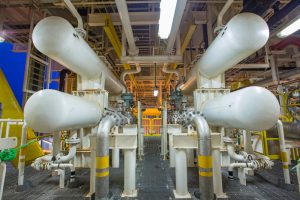
When storing or transporting gases or liquids under high pressure, and typically high temperatures, pressure vessels are the vessels of choice. Aerospace, automotive, energy, oil and gas, and other sectors all make use of these vessels.
Improvements in materials, design, and production methods have allowed for substantial development in the field of pressure vessel technology over time. Steel, aluminium, and composites are all used in modern pressure vessels, and cutting-edge design and production methods like finite element analysis and automated welding are standard.
Importance Of Pressure Vessels In Various Industries
Industries rely heavily on pressure vessels, which are used to store and transport pressurised gases and liquids. For instance, compressed natural gas is stored in pressure vessels in the automotive sector, while natural gas and hydrogen are stored in pressure vessels in the energy business. Pressure vessels serve many purposes in the oil and gas sector, including warehousing, transporting, and processing various oil and gas products. In a nutshell, many different businesses cannot function without the use of pressure vessels.
Advancements In Pressure Vessel Materials
Following are some of the more recent advancements in pressure vessel materials:
1). Carbon Fibre Composites
Carbon fibre composites are one of the most promising materials for pressure vessels due to their high strength-to-weight ratio, corrosion resistance, and durability. Carbon fibre composites are made by weaving together carbon fibres and then coating them with a resin matrix. These composites are used in various industries, such as aerospace, automotive, and energy, for applications such as hydrogen storage and fuel cells.
2). Hybrid Materials
Hybrid materials are a combination of different materials that offer unique advantages for pressure vessel applications. For example, a hybrid pressure vessel could use a carbon fibre composite exterior for high strength and durability, with a metallic interior liner for improved gas compatibility. Hybrid materials also offer the potential for tailoring the material properties to meet specific application requirements.
3). Other Emerging Materials
Other emerging materials, such as graphene and nanotubes, are also being explored for pressure vessel applications. Graphene is a two-dimensional material with exceptional mechanical and electrical properties, and it has the potential to improve the strength and durability of pressure vessels. Nanotubes are cylindrical structures made of carbon atoms and have high strength and flexibility, making them promising for use in pressure vessels.
Advances In Pressure Vessel Design
Additive manufacturing, also known as 3D printing, is a promising technique for pressure vessel design and fabrication. With this technique, pressure vessels can be printed layer by layer using a variety of materials, including metals, plastics, and composites. Additive manufacturing offers many benefits, such as reduced lead times, increased design flexibility, and the ability to produce complex geometries that are difficult to fabricate using traditional manufacturing techniques.
Computational modeling is another promising approach for pressure vessel design. With this technique, pressure vessels can be designed and optimised using advanced computer simulations. These simulations can accurately predict the behavior of pressure vessels under different conditions, such as varying pressures and temperatures, and can help optimise the vessel design for improved performance and safety.
Optimisation techniques are used to improve the design of pressure vessels by minimising weight, maximising strength, and reducing manufacturing costs. These techniques use advanced algorithms and software tools to explore a range of design options and identify the optimal design for a given application. Optimisation techniques can help reduce material waste, improve efficiency, and enhance the performance and safety of pressure vessels.
Safety And Maintenance Of Future Pressure Vessels
Safety is of utmost importance in pressure vessel technology, as any failure or malfunction can have severe consequences. It is essential to ensure that pressure vessels are designed, fabricated, and tested to meet industry standards and safety requirements to prevent accidents and ensure the integrity of the vessels. Safety considerations should be taken into account during all phases of the pressure vessel life cycle, from design to disposal.
Regular Inspection And Maintenance Of Pressure Vessels
Regular inspection and maintenance are necessary to ensure the continued safe operation of pressure vessels. Inspection techniques, such as visual inspections, non-destructive testing, and pressure testing, are used to detect any defects or signs of deterioration. Maintenance tasks, such as cleaning, painting, and repair, are also essential for the upkeep of pressure vessels. The frequency of inspection and maintenance depends on the type of pressure vessel and its usage, but it is typically recommended to have them inspected and maintained at least once a year.
Preventing Pressure Vessel Failures
Pressure vessel failures can occur due to various reasons, including corrosion, fatigue, and overpressure. To prevent failures, pressure vessels should be designed and fabricated to meet industry standards and safety requirements. Proper use, inspection, and maintenance of pressure vessels are also essential for preventing failures. Monitoring the pressure and temperature inside the vessel, using pressure relief valves, and ensuring the proper use of the vessel can also help prevent failures.
Final Thoughts
Sherwood Design & Engineering has a long and successful history of providing high-quality pressure vessel solutions for a wide range of industries. Our expertise in pressure vessel design, fabrication, and testing, combined with our commitment to safety and customer satisfaction, has made us a trusted partner for many companies around the world. As pressure vessel technology continues to evolve and advance, it is clear that Sherwood Design & Engineering will continue to be at the forefront of this industry, providing innovative and efficient solutions to meet the needs of our clients.
Give us a call at (02) 9437 3566 or leave an enquiry if you would like to learn more about our pressure vessel engineering design and support services.
